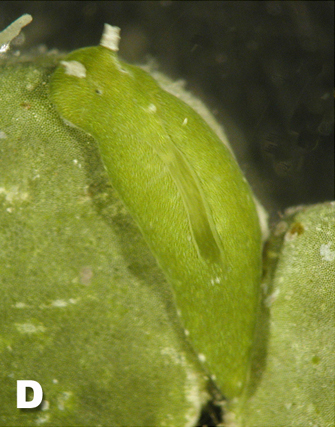
Photo Credit: Heike Wägele & Annette Klussmann-Kolb*
Synonyms: Elysiella pusilla, Elysia dubiae, Elysia halimedae, Elysia latipes
Description: Small to medium (to 32 mm) species, with shape and color to match Halimeda species and stages on which they are feeding. Parapodia reduced compared to other Elysia species, which has led some authors to place it in a separate genus, Elysiella.
Distribution: tropical western Pacific and Indian Oceans
Food Plants: Halimeda
Scientific Papers:
Mehrotra R, Monchanin C, Scott CM, Phongsuwan N, Caballer Gutierrez M, Chavanich S, Hoeksema BW. (2019) Selective consumption of sacoglossan sea slugs (Mollusca: Gastropoda) by scleractinian corals (Cnidaria: Anthozoa) PLoS One 14: e0215063. [NH] [Pu]
Vendetti, J.E., Trowbridge, C.D., Krug, P.J. (2012) Poecilogony and population genetic structure in Elysia pusilla (Heterobranchia: Sacoglossa), and reproductive data for five sacoglossans that express dimorphisms in larval development Integrative and Comparative Biology, 52 (1), pp. 138-150. PDF [NH] [Pu]
Handeler, K., Wagele, H., Wahrmund, U., Rudinger, M., Knoop, V. (2010) Slugs’ last meals: Molecular identification of sequestered chloroplasts from different algal origins in Sacoglossa (Opisthobranchia, Gastropoda). Molecular Ecology Resources, 10 (6), pp. 968-978. PDF [Pu] [To] [Vi]
Evertsen, J., Burghardt, I., Johnsen, G., Wägele, H. (2007) Retention of functional chloroplasts in some sacoglossans from the indo-pacific and Mediterranean. Marine Biology, 151 (6), pp. 2159-2166. PDF [K] [Pu] [Ti] [To]
Raven, J.A., Walker, D.I., Jansen, K.R., Handley, L.L., Scrimgeour, S.M., McInroy, S.G. (2001) What fraction of organic carbon in sacoglossans is obtained from photosynthesis by kleptoplastids? An investigation using the natural abundance of stable carbon isotopes. Mar. Biol. 138: 537-545 [Au] [Ex] [Ma] [Pu]
Williams, S.I., Walker D.I. (1999) Mesoherbivore-macroalgal interactions: feeding ecology of sacoglossan sea slugs (Mollusca, Opisthobranchia) and their effects on food algae. Oceanogr Mar Biol Annu Rev 37: 87-128 [At] [Au] [Ca] [Ev] [Ex] [Fi] [Fu] [He] [Ma] [Or] [Pa] [Pu] [Se] [Su] [Ti] [Tu] [Vi] Excellent review of food sources
Paul, V.J. & van Alstyne, K.L. (1988) Use of ingested algal diterpenoids by Elysia halimedae Macnae (Opisthobranchia : Ascoglossa) as antipredator defenses. J. Exp. Mar. Biol. Ecol. 119: 15 [Pu]
Hay, M.E., Pawlik, J.R., Duffy, E., Fenical, W. (1989) Use of ingested algal diterpenoids by Elysia halimedae Macnae (Opisthobranchia : Ascoglossa) as antipredator defenses. Oecologoa 81:418-427 [Pu]
*”Elysiella pusilla” by Heike Wägele & Annette Klussmann-Kolb – cropped from Figure 1 from:Heike Wägele & Annette Klussmann-Kolb: Opisthobranchia (Mollusca, Gastropoda) – more than just slimy slugs. Shell reduction and its implications on defence and foraging. – Frontiers in Zoology 2005, 2:3. doi:10.1186/1742-9994-2-3. Licensed under Creative Commons Attribution 2.0 via Wikimedia Commons –
Recent Comments